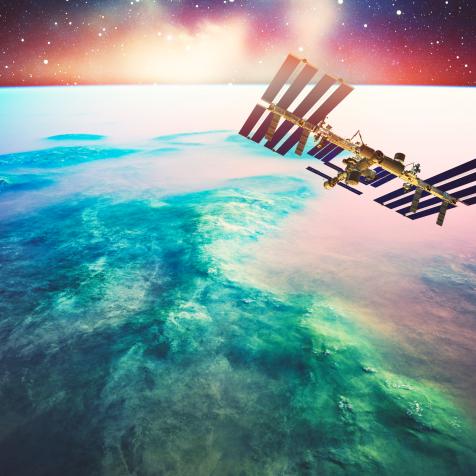
Science Photo Library - ANDRZEJ WOJCICKI
An Asteroid is Going to Kill Us All Before the Election... Or Not

So you may have heard the news by now that an asteroid is hurtling towards the Earth.
Currently, this asteroid is scheduled to wipe us all out on November 2, the day before Election Day. And while I'm sure some of you are considering voting for "Asteroid Impact" as a write-in candidate for the general election, I'm here to tell you that you need to cool your jets (and probably vote for a human being).
The Candidate in Question

NASA/JPL-Caltech
This is a diagram of the asteroid's trajectory, in white.. Notice the Earth's orbit in blue.
The particular asteroid in question was discovered in 2018 with the Zwicky Transient Facility, a fantastically giant telescope in Palomar, California. It has a name, 2018 VP1, although I hereby petition renaming it to "The Third Party". It's about the size of a car, and as asteroids go, it is wholly unremarkable. Except for the fact that it's headed right for us. I mean, sort of.
It's hard to track the trajectories of asteroids out there in space and predict where they're going to go. The problem is that asteroids are very, very small and also they're very dull--that's a part of the definition of being an asteroid rather than something cooler like a planet. I mean, I'm sure they have sparkling personalities, but their surfaces are very drab and gray making them hard to see. Even though we spotted 2018 VP1 a couple years ago, we kind of lost track of it until recently.
But even with more dedicated observations, we still have a hard time pinning down exactly where the asteroid is going to go. That's because there are all sorts of little things that can dramatically alter an asteroid's trajectory, like how evenly its surfaces get heated by the sun or how close it comes to any other nearby wandering piece of space debris.
Based on our best estimates, the asteroid 2018 VP1 has less than half a percent chance of striking the Earth on November 2.
But if that's not enough to soothe your worries on whether you can make it to the voting station, let's look at the worst-case scenario and assume that 2018 VP1 really is going to slam into the Earth. What will be the effects?
Potential Aftermath
Well, for the asteroid it's going to be a very bad day. Because it's traveling at extreme velocities (we're talking tens of thousands of miles per hour here), our atmosphere, as thin as it is, is going to feel like concrete. The asteroid will simply burn up in our atmosphere. If it's especially lucky and comes in at a shallow angle and has a very dense core, that core might survive passage to the surface. In which case, a fist-sized lump of iron will go plunk in one of our oceans.
And as for the Earth? Well it'll just keep going on being Earth.
2018 VP1 is simply not a hazard. It is neither the closest asteroid to skim the Earth, nor the largest potentially dangerous asteroid that we know of. NASA has been tracking potentially dangerous asteroids for decades through its Planetary Defense Coordination Office. I must say, that's the coolest name possible for a bunch of astronomers sitting around staring at their computer screens all day.
Early Warning System

NASA/JPL
The streak circled in the center of this image is asteroid 2020 QG, which came closer to Earth than any other nonimpacting asteroid on record. It was detected by the Zwicky Transient Facility on Sunday, August 16.
You're starting to hear about these "near-miss" asteroids more often because now we have things like the Zwicky Transient Facility, which are better able to see these small rocks that in previous generations, just whooshed on by without notice. So be prepared for scary-sounding headlines to come. And I mean about asteroids, not the election.


















